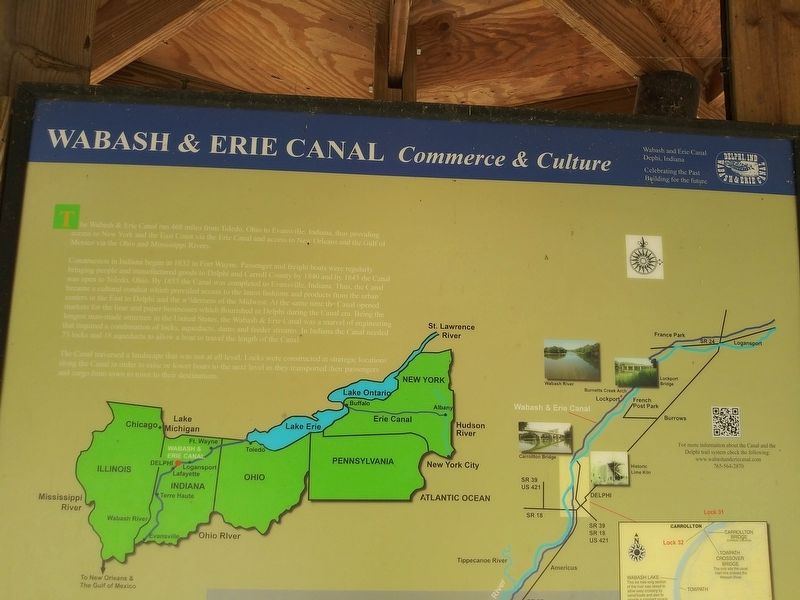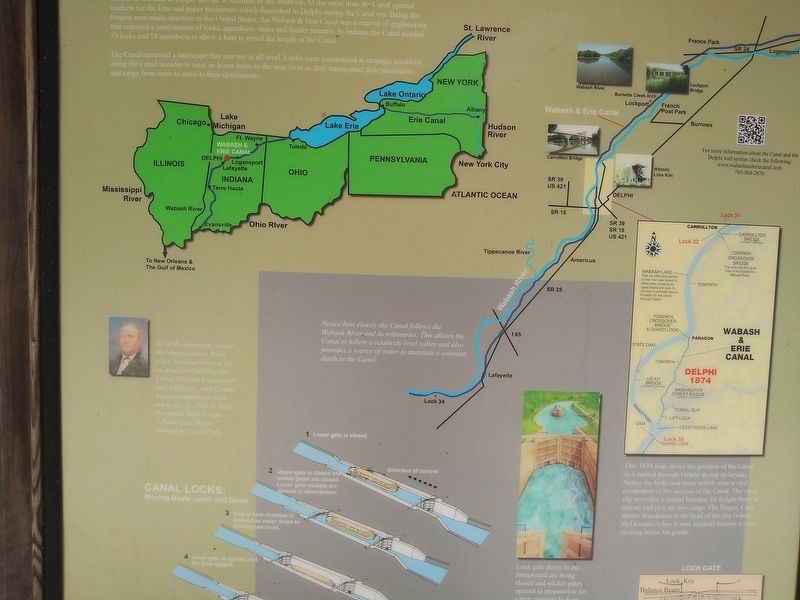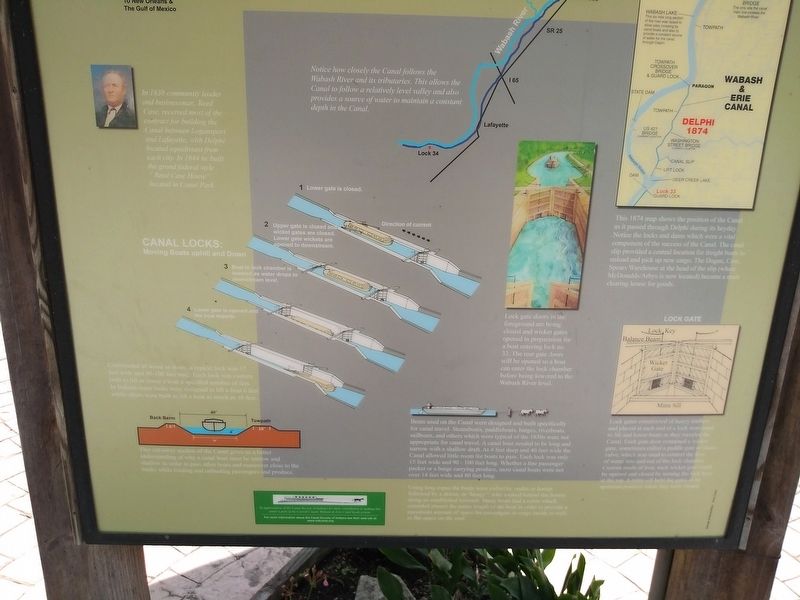Wabash & Erie Canal
Commerce & Culture
— Wabash & Erie Canal Park Village —
The Wabash & Erie Canal ran 468 miles from Toledo, Ohio to Evansville, Indiana, thus providing access to New York and the East Coast via the Erie Canal and access to New Orleans and the Gulf of Mexico via the Ohio and Mississippi Rivers.
Construction in Indiana began in 1832 in Fort Wayne. Passenger and freight boats were regularly bringing people and manufactured goods to Delphi and Carroll County by 1840 and by 1843 the Canal was open to Toledo, Ohio. By 1853 the Canal was completed to Evansville, Indiana. Thus, the Canal became a cultural conduit which provided access to the latest fashions and products from the urban centers in the East to Delphi and the wilderness of the Midwest. At the same time the Canal opened markets for the lime and paper businesses which flourished in Delphi during the Canal era. Being the longest man-made structure in the United States, the Wabash & Erie Canal was a marvel of engineering that required a combination of locks, aqueducts, dams and feeder streams. In Indiana the Canal needed 73 locks and 18 aqueducts to allow a boat to travel the length of the Canal.
The Canal traversed a landscape that was not at all level. Locks were constructed at strategic locations along the Canal in order to raise or lower boats to the next level as they transported their passengers and cargo
from town to town to their destinations.In 1838 community leader and businessman, Reed Case, received most of the contract for building the Canal between Logansport and Lafayette, with Delphi located equidistant from each city In 1844 he built the grand federal style "Reed Case House" located in Canal Park.
Notice how closely the Canal follows the Wabash River.and its tributaries. This allows the Canal to follow a relatively level valley and also provides a source of water to maintain a constant depth in the Canal.
This 1874 map shows the position of the Canal as it passed through Delphi during its heyday. Notice the locks and dams which were a vital component of the success of the Canal. The canal slip provided a central location for freight boats to unload and pick up new cargo. The Dugan, Case. Spears Warehouse at the head of the slip (where McDonalds/Arbys is now located) became a main clearing house for goods.
Canal Locks:
1. Lower gate is closed.
2. Upper gate is closed and wicket gates are closed. Lower gate wickets are opened to downstream.
3. Boat in lock chamber is lowered as water drops to downstream level.
4. Lower gate is opened and the boat departs.
Constructed of wood or stone, a typical lock was 15 feet wide and 90-100 feet long Each lock was custom built to lift or lower a boat a specified number of feet. In Indiana some locks were designed to lift a boat 6 feet while others were built to lift a boat as much as 10 feet.
This cut-away section of the Canal gives us a better understanding of why a canal boat must be narrow and shallow in order to pass other boats and maneuver close to the banks while loading and unloading passengers and produce.
Lock gate doors in the foreground are being closed and wicket gates opened in preparation for a boat entering lock no. 32. The rear gate doors will be opened so a boat can enter the lock chamber before being lowered to the Wabash River level.
Boats used on the Canal were designed and built specifically for canal travel. Steamboats, paddleboats, barges, riverboats, sailboats, and others which were typical of the 1830s were not appropriate for canal travel. A canal boat needed to be long and narrow with a shallow draft. At 4 feet deep and 40 feet wide the Canal allowed little room for boats to pass. Each lock was only 15 feet wide and 90 - 100 feet long. Whether a fine passenger packet or a barge carrying produce, most canal boats were not over 14 feet wide and 80 feet long.
Using long ropes the boats were pulled by mules or horses followed by a driver, or "hoagy", who walked behind the horses along an established towpath. Many
boats had a cabin which extended almost the entire length of the boat in order to provide a maximum amount of space for passengers or cargo inside as well as flat space on the roof.
Lock gates constructed of heavy timbers
and placed at each end of a lock werened
to lift and lower boats as they traveled
Canal. Each gate door contained a wicket
gate, sometimes called a paddle gate
valve, which was needed to control the flow
of water into and out of the lock channel
Custom made of iron, each wicket gate could
be opened and closed by turning the lock keys
at the top. A mitre sill beld the gates in an
upstream pattern when they were closed.
Topics and series. This historical marker is listed in these topic lists: Industry & Commerce • Waterways & Vessels. In addition, it is included in the Wabash & Erie Canal series list. A significant historical year for this entry is 1832.
Location. 40° 35.483′ N, 86° 40.833′ W. Marker is in Delphi, Indiana, in Carroll County. Marker can be reached from the intersection of West North Washington Street and North Charles Street, on the right when traveling east. The marker is on the Grounds of the Wabash & Erie Canal Conference & Interpretive Center. Touch for map. Marker is at or near this postal address: 12252 West North Washington Street, Delphi IN 46923, United States of America. Touch for directions.
Other nearby markers. At least 8 other markers are within walking distance of this marker
Credits. This page was last revised on December 25, 2020. It was originally submitted on December 25, 2020, by Craig Doda of Napoleon, Ohio. This page has been viewed 123 times since then and 5 times this year. Photos: 1, 2, 3. submitted on December 25, 2020, by Craig Doda of Napoleon, Ohio. • Devry Becker Jones was the editor who published this page.


